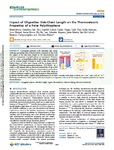Impact of Oligoether Side-Chain Length on the Thermoelectric Properties of a Polar Polythiophene

Use this link to cite
http://hdl.handle.net/2183/38062
Except where otherwise noted, this item's license is described as CC BY 4.0 https://creativecommons.org/licenses/by/4.0/
Collections
- Investigación (EPEF) [590]
Metadata
Show full item recordTitle
Impact of Oligoether Side-Chain Length on the Thermoelectric Properties of a Polar PolythiopheneDate
2024-05-28Citation
Craighero, M., Guo, J., Zokaei, S., Griggs, S., Tian, J., Asatryan, J., et al. (2024). Impact of Oligoether Side-Chain Length on the Thermoelectric Properties of a Polar Polythiophene. ACS Appl. Electron. Mater. 6, 2909–2916. doi: 10.1021/acsaelm.3c00936
Abstract
[Abstract]: Conjugated polymers with oligoether side chains make up a promising class of thermoelectric materials. In this work, the impact of the side-chain length on the thermoelectric and mechanical properties of polythiophenes is investigated. Polymers with tri-, tetra-, or hexaethylene glycol side chains are compared, and the shortest length is found to result in thin films with the highest degree of order upon doping with the p-dopant 2,3,5,6-tetrafluoro-7,7,8,8-tetracyanoquinodimethane (F4TCNQ). As a result, a stiff material with an electrical conductivity of up to 830 ± 15 S cm–1 is obtained, resulting in a thermoelectric power factor of about 21 μW m–1 K–2 in the case of as-cast films. Aging at ambient conditions results in an initial decrease in thermoelectric properties but then yields a highly stable performance for at least 3 months, with values of about 200 S cm–1 and 5 μW m–1 K–2. Evidently, identification of the optimal side-chain length is an important criterion for the design of conjugated polymers for organic thermoelectrics.
Keywords
Conjugated polymer
Side-chain length
Organic thermoelectrics
Chemical doping
Electrical conductivity
Side-chain length
Organic thermoelectrics
Chemical doping
Electrical conductivity
Editor version
Rights
CC BY 4.0 https://creativecommons.org/licenses/by/4.0/
ISSN
2637-6113






